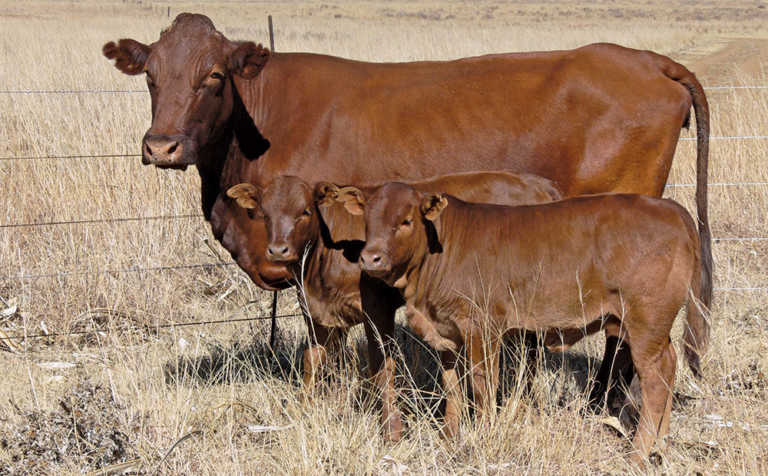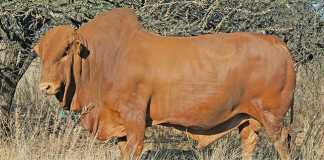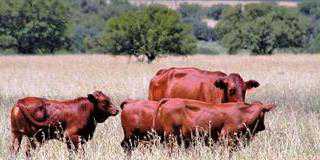
Photo: Chris Nel
When managing heifers and first-calf cows, the first step is to get the maximum number of heifers pregnant as early as possible.
Ideally, they should be pregnant before 27 months so that they calve before 36 months.
The timing should also fit into a herd’s breeding season to ensure that the cheapest source of high quality feed – good summer grazing (in a summer rainfall area) – is used optimally.
Having said this, weight, condition and growth rate are more important than age in determining when to breed a heifer as this will determine the health of both cow and calf.
General practices
Ensure that heifers are suited to the production environment. First calvers have high nutritional needs as they are growing while suckling their calves.
Their reproductive ability will suffer if they lose too much condition. Manage heifers and first-calvers in a separate group until they calve for the second time.
Breeding
- Get a heifer to 65% of expected mature weight at breeding – If the average mature cow weighs 500kg, the heifer should weigh about 325kg at the beginning of the breeding season. A heifer should be 80% to 85% of her expected mature weight before calving.
- Use a short breeding season – The heifer herd’s breeding season is 45 to 65 days. A short breeding and calving season applies selection pressure on fertility and allows for better supervision during calving.
- Breed the heifers four to six weeks before the rest of the herd – This gives them a longer post calving recovery period, which should lead to a higher re-conception rate. They must have adequate nutrition before and after calving until sufficient grass is available, or they will lose too much condition, which could cause a lower re-conception rate. Wean heifers’ calves earlier than the other calves to avoid too much condition loss.
- Breed heavy or fat heifers at 18 to 21 months – This should be considered only if enough good quality pasture, crop residue, hay or silage is available after calving to ensure that conditions remain optimal for re-conception. Resting these first-calf cows for six months before they are re-bred (to calve in the main calving season) will ensure higher re-conception. Heifers can be bred at 12 to 15 months if the nutritional status and management of the herd is high and target breeding weights have been reached.
- Breed more heifers than necessary – Up to 50% more heifers than required for replacement should be bred so that there are enough pregnant heifers available to replace all non-pregnant cows and cows that need to be culled for other reasons.
- Consider synchronisation – Synchronise ovulation to get heifers in calf as early as possible during a short breeding season.
- Use proven ease-of-calving bulls on heifers – Apart from increasing the risk of calf/cow mortalities, difficult calving extends the postpartum recovery period, leading to reduced re-conception. Use bulls with a relatively low breeding value for birth weight on heifers to ensure easy calving.
- Use more bulls with heifers – Using 15 to 20 heifers per bull – especially during the first 21 days of the breeding season – will ensure that cycling heifers receive more attention, and will lead to a higher conception rate early on.
- Use teaser bulls – The exposure of heifers and first-calf cows to teaser bulls for at least nine days before the start of the breeding season will encourage them to start ovulating and help with earlier pregnancies.
Feeding
- Condition of heifers at mating and calving is critical – On a 1 to 5 point scale (where 1 = very lean; 5 = very fat), heifers must be 2,5 to 3 at breeding and 3 to 3,5 at calving. The feeding level of first-calvers must be increased to maintain body condition. Providing the best available nutrition (whether pasture, hay or crop residues and a lick) to first-calvers calving will prevent loss of condition.
- Supplements – Licks must have a balance of protein, energy, minerals and trace elements, and should be adjusted seasonally according to the quality of the grazing and the heifers’ condition.
- Provide a lick – A stimulation lick from 21 days before the start of the breeding season until 42 days into the season will help to achieve a high conception rate. Excessive energy supplementation in the last trimester can lead to large calves, difficult calving, longer postpartum recovery and delayed re-conception. Over-wintering heifers on maize stover can increase birth weights and heifer weight resulting in difficult calving.
Other
Assist calving when necessary. If a heifer has been calving for 90 minutes in Stage 2 (hooves visible), each 30-minute delay adds six days to the interval between calving and re-conception.
Consider creep feeding for first-calf cows’ calves, especially if pasture is poor. Wean early during feed shortages. Weaning earlier helps improve the reproduction rate of first-calvers.
Leslie Bergh is a senior researcher, Beef Cattle Recording and Improvement, at the Agricultural Research Council’s Animal Production Institute in Irene.













